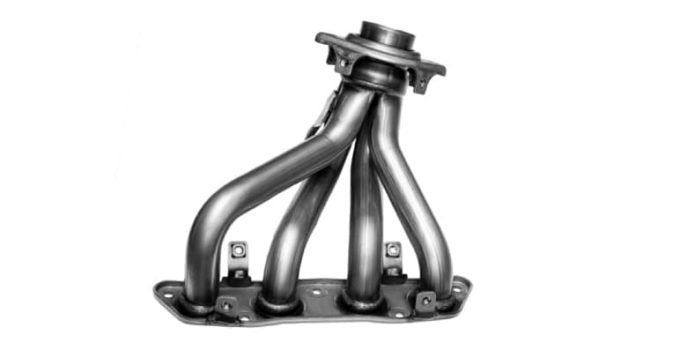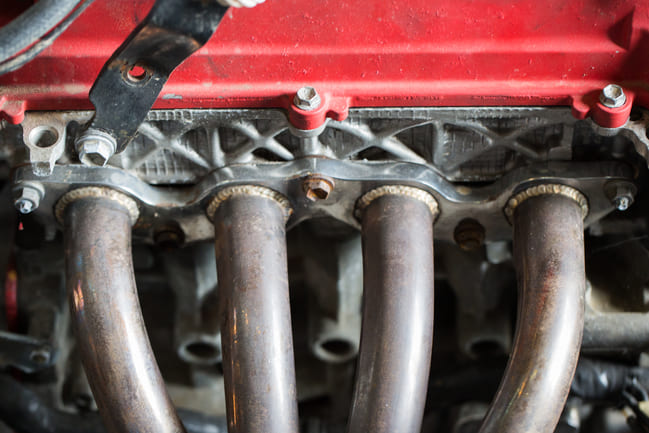
The exhaust manifold on your engine is subject to enormous loads. Nevertheless, this component is rarely the center of regular maintenance work. This component is particularly important for optimum engine performance. In addition, this component must not be leaking, which could otherwise result in serious environmental pollution. In the following article we explain the symptoms of a leaking exhaust manifold. Among other things, it can happen that you have problems with the lambda probe, but in reality only the connecting component has become leaky.
Contents
The function and the material of your exhaust manifold

In order to be able to repair an exhaust manifold at all, you must first understand its function. Basically, this component is the connection between your vehicle engine and the exhaust system. It is bolted directly to the engine block. Depending on the engine, the design must fit exactly, so you have to plan an exhaust manifold carefully. This applies in particular when standard components are no longer available for older vehicles. Then it is particularly important that the new spare part corresponds to the necessary parameters. The material of an exhaust manifold is usually cast iron of a special alloy. In this way, the necessary strength and, in particular, the desired resistance to the exhaust gas temperatures, which can be in the range of 900 °C, are achieved. In modern vehicles, stainless steel is increasingly being used as an alternative. So this component is particularly durable and it can also be lighter and more compact. After the engine has burned the fuel, the resulting exhaust gases are combined. The exhaust gases can then be routed to the turbocharger or to a collecting pipe for further exhaust gas treatment. After the catalytic converter and/or other components for cleaning exhaust gases, these can then be cleaned and discharged to the outside via the exhaust. In many cases, the exhaust manifold is fastened with screws.
The most important parameters of an exhaust manifold
Of course, a car manifold has to fit your engine, but just fitting is not enough, because there are several other parameters that determine the structure and performance of this component. We had already spoken briefly about the material.

As described, there is now the possibility of using special stainless steel, with which significantly lighter components of this type can be built. However, it is important to note that these components must be designed to withstand high temperatures, otherwise they will not have a particularly long service life. This is also particularly important if you actually intend to build a new manifold yourself.
Finally, there are a number of other factors that affect how the exhaust flows through this component. This also includes, for example, the surface roughness in the interior of this component. In addition, the respective pipe lengths, the pipe diameters and the exact design of the curvature and also the arrangement or sequence in which all exhaust gas flows are finally combined determine the flow behavior. While most standard manifolds are made of cast iron, so-called exhaust manifolds, which have a smooth surface, are made of stainless steel sheet. This should increase the engine performance achieved in the medium and low engine speed range. At the same time, the lower component weight has a positive effect on driving dynamics. What is interesting is the development that some engine manufacturers have started to integrate the manifold function into the respective engine cylinder and thus the engine block. This not only results in lower weight, but also higher performance and better cooling. At the same time, you do not need any sealant for your exhaust manifold.
How does an exhaust manifold actually leak?

The most common problem with an exhaust manifold is that it leaks. This means that it can no longer be guaranteed that all exhaust gases are properly discharged from the cylinders and fed to the exhaust aftertreatment. In particular, if you use a turbocharger, this can also manifest itself in a massively reduced engine performance. In such a case, the first step should be to check your entire exhaust system. At the same time, it is advisable to check whether you should clean the particulate filter that may be present.
Your exhaust manifold is usually leaking due to a crack or a break. The reason for this is usually the large temperature fluctuations. Other causes can be vibrations while driving, worn seals and fasteners, lack of flexibility in connections and damage to the suspension and distributor. This is usually noticeable by a significant change in your usual engine noise. Your vehicle can suddenly sound a lot sportier, even though you haven't put any effort into it. The loss of engine power is also usually accompanied by increased fuel consumption. Finally, your specialist workshop can carry out an exact diagnosis and determine where the problem with your exhaust system lies. They can also help you if you want the exhaust manifold to be ground flat or if you want to have it cleaned.
The repair of your car manifold
When repairing an exhaust manifold, the primary goal is to restore its tightness. Your specialist workshop can select the appropriate procedure, but in many cases an exchange is advisable. First of all, however, the component is removed so that it can be determined at all what damage is present. This is the only way to detect cracks and determine whether the component geometry has already changed. If only the seals are affected, they can often be easily replaced. If your workshop offers to repair the exhaust manifold by welding, you should exercise caution. In most cases, this is more of a patchwork job than a really useful repair. This becomes particularly clear when you consider that such components for an average car only cost around €200 as a new part. Including installation and removal as well as the necessary seals, you are in the middle three-digit range for replacing your exhaust manifold.
Conclusion
If this component leaks, the problem must be rectified as soon as possible. Only by sealing your exhaust manifold can you restore its correct function. This ensures the desired after-treatment of exhaust gases and no harmful exhaust gases escape directly from the engine into the environment. In addition, a crack in this component can even lead to a lack of engine performance. This is especially true if you drive a vehicle with a turbocharger.
A tip from CarTipsandmore: Some specialists also dare to build their own exhaust manifold. We can only strongly advise you not to do this if you are not an expert. Nevertheless, with the help of the appropriate expert advice, you can set about improving the geometry of this component. You should plan the exhaust manifold carefully beforehand so that there are no nasty surprises later. However, when it comes to increasing the performance of your vehicle engine, you should consider chip tuning. This is much easier to implement, promises faster and safer success and can also be easily reversed in many cases.
